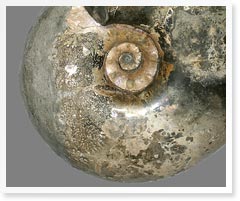De-accessioning
Within a collection there may be many examples of fossils of the same species. These are not “extras” or “spares”; series of specimens are essential for research and are one of the most important reasons that institutions hold collections.
It is rare that a museum will want to dispose of a specimen simply because it is one of several examples of that species. However, there are some circumstances in which an institution may feel that it is no longer appropriate or necessary to hold onto a particular fossil, and may choose to remove the specimen from its collections. This process is called deaccessioning.
Deaccessioning is carried out when a specimen has been damaged beyond recovery or repair, or is no longer relevant to the scope and purpose of the collections. There are a number of different methods by which deaccessioning can be carried out, including exchange, donation, sale, or destruction.

Why might my institution decide to deaccession something?
Examples of reasons for deaccessioning of specimens include:
- The specimen is so badly damaged that it can no longer be used;
- The material does not relate the institution’s current mission;
- The available data are insufficient to properly document the specimen;
- The specimen is a health hazard;
- The specimen has little scientific or educational value;
- The specimen will be destroyed or completely consumed during important scientific sampling (“destructive analysis”);
- Ownership of the specimen has been determined to be inappropriate for the institution;
- The specimen is being returned to the country or place of origin;
- The institution is unable to provide sufficient care, and another repository has been identified that is more suitable and is willing to accept it.
Preferred Methods of Deaccessioning
Preference should be given to placing material that is part of the historical, cultural, or scientific legacy of a particular region, state or country at institutions within that region, state or nation, respectively. Alternatively, the specimen can be transferred internally within the holding institution (e.g., from a scientific collection to an education department for use in public programs).Deaccessioning a specimen is an extremely significant step for an institution or individual, because by accessioning the specimen you accepted responsibility for its long term housing and care. For this reason, it is important that the decision to remove or dispose of an object from a collection is considered carefully, and that the process of deaccessioning takes place in a responsible and ethical manner.
If you are an individual with a fossil collection you might want to ask yourself why you are dropping the responsibility for a particular fossil? What are you going to do with it now? Would having a more thought out collection plan prevent this problem in the future?
What do I do with the specimen after it has been deaccessioned?
For an institution with legal responsibility for a specimen, the process of deaccessioning is generally done in one of two ways:
By Sale
In general, ethical issues tend to weigh against the sale of objects from museum collections; however, selling of specimens may be an acceptable method of disposal under certain circumstances. Nonetheless, the sale of specimens can be a very contentious issue and should not be undertaken without consultation with all appropriate institutional staff.
If the object is offered for sale, it is preferable that the sale take place via a public auction or the public market place in a way that best protects the interests of the museum. The proceeds from the sale should be used for acquisitions to the collections or for direct management, care or preservation of the collections as specified by the institution’s collection policy.
By Discarding or Destruction
If a specimen has lost all of its value to the collections because of alteration, replication, deterioration or other compelling reason(s) and has no value for education, exchange, sale, or donation, it can be discarded or destroyed.
To prevent ethical conflicts of interest, it is best to avoid giving or selling specimens privately to museum employees, or to other people with a professional association with the institutions, such as members of the board of trustees or committees. Because these ethical issues can be so sensitive, this course of action is preferable even if it seems like a less drastic solution than destroying the specimen.



